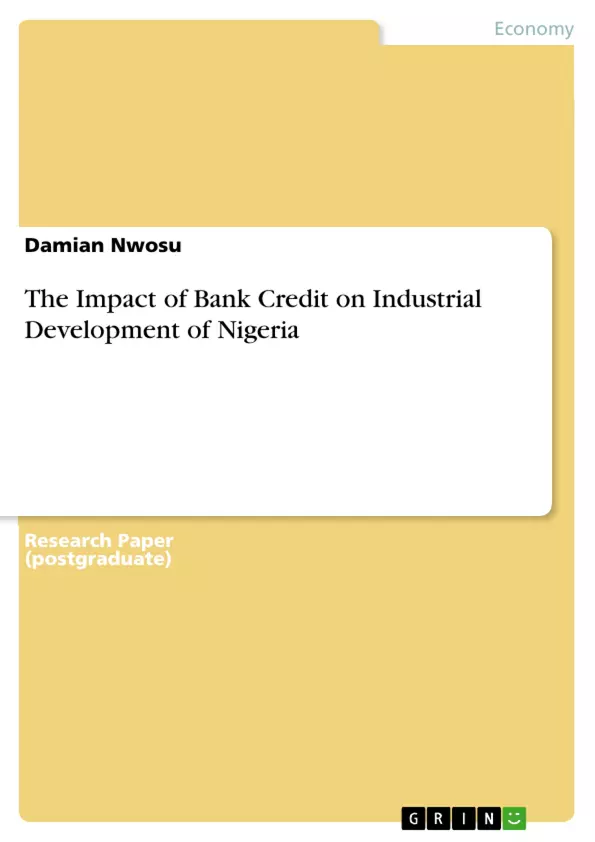The ongoing financial crisis has reinforced the importance of capital in the industrial development and economic growth of a country. In the last two years, industries have closed down owing to lack of capital occasioned by the global financial meltdown. From America, London, other European countries, Asia and Africa, governments have had to intervene in other to bail out some ailing industries and forestall total collapse of the economy. These show the importance of credit either from bank or any other means to industries.
Recognizing the importance of capital in economic growth, Mackinnon and Shaw (1973), outlined the procedures for strengthening the financial sector of an economy so as to enable it play the all important role of providing capital for industrial development. Among the basic explanations for this is that the financial sector serves to reallocate funds from the supply side, given their investment opportunities, to the demand side with a shortage of funds. Thus, an economy with well-developed financial institutions will be better able to allocate resources to industries that yield the highest returns.
The manufacturing sector is a catalyst to the modern economy and has a many dynamic benefits that are crucial for economic transformation, (Loto, 2005). The manufacturing sector is a leading sector. It helps to increase productivity in relation to import substitution, export expansion, creating foreign exchange earning capacity, raising employment and per capital income which according to Loto, (2005), widens the scope of consumption in dynamic patterns. Ogwuma, (1995) asserts that the manufacturing sector promotes the growth of investment at a faster rate than any other sector of the economy as well as wider and more efficient linkages among different sectors.
Inhaltsverzeichnis (Table of Contents)
- INTRODUCTION
- LITERATURE REVIEW
- STYLIZED FACTS ABOUT BANK CREDIT AND INDUSTRIAL GDP IN NIGERIA
- Table.1 Total Credit and Credit to the Industrial Sectors in Nigeria
- Table.2 Total GDP and Industrial Sectors GDP in Nigeria
- EMPIRICAL METHODOLOGY AND ANALYSIS OF RESULTS
- THEORY
- THE MODEL
- Table 3: Definition and Source of Variable
- THE METHODOLOGY
- Empirical Results
- Unit Root Results
- Table 4: Augmented–Dickey Fuller (ADF) Test
- Table 5: Phillips–Perron (PP) Test
- Co‐integration Tests Results
- Table 6: Johansen‐Juselius Co‐integration Tests.
- Error Correction Models
- ANALYSIS OF RESULTS
- Table 7: Parsimonious Error Correction Models
- Test for Structural Stability
- Figure 1: The CUSUM and CUSUMSQ Tests
- SUMMARY AND CONCLUSIONS
- The role of bank credit in industrial development
- The impact of interest rates on industrial growth
- The relationship between the number of banks and industrial output
- The applicability of endogenous growth theory to the Nigerian context
- Policy implications for promoting industrial development in Nigeria
Zielsetzung und Themenschwerpunkte (Objectives and Key Themes)
This study investigates the impact of bank credit on industrial development in Nigeria from 1970 to 2008. The aim is to understand the extent to which bank credit has influenced industrial growth and provide insights for policymaking. The research is grounded in the endogenous growth theory, which highlights the role of capital in driving economic growth. The study explores the relationship between bank credit and industrial output, taking into account other relevant factors like interest rates and the number of banks.
Zusammenfassung der Kapitel (Chapter Summaries)
The introduction provides a context for the study, highlighting the importance of capital in industrial development and economic growth, especially in light of the recent global financial crisis. It examines the Nigerian government's efforts to support the industrial sector through various initiatives, including the National Economic Reconstruction Fund (NERFUND) and the Bank of Industry (BOI). The chapter concludes by posing the question of the true impact of bank credit on industrial development in Nigeria.
The literature review examines existing research on the relationship between credit and industrial growth. It discusses the role of financial institutions in allocating resources to industries with the highest returns and the importance of trade credit as a source of financing for constrained firms.
The chapter on stylized facts provides an overview of the Nigerian industrial sector's performance in terms of GDP contribution and the allocation of credit. It presents data showing the share of credit allocated to the industrial sector over time, highlighting the decline in recent years.
The empirical methodology and analysis of results section details the methodology employed in the study, including the choice of variables, data sources, and econometric techniques. It outlines the unit root and co-integration tests conducted to determine the stationarity properties of the variables and the appropriate estimation procedure.
Schlüsselwörter (Keywords)
This study focuses on the impact of bank credit on industrial development in Nigeria. Key areas of focus include the relationship between bank credit and industrial output, the role of interest rates and the number of banks, and the relevance of endogenous growth theory in explaining the dynamics of industrial growth in developing economies.
- Quote paper
- Damian Nwosu (Author), 2011, The Impact of Bank Credit on Industrial Development of Nigeria, Munich, GRIN Verlag, https://www.grin.com/document/229473



